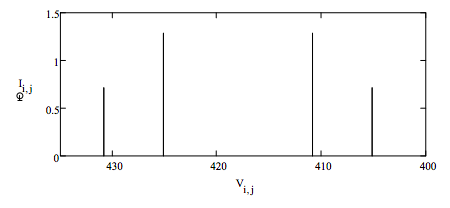4.22: AB Proton NMR Analysis for 2,3-dibromothiophene
- Page ID
- 150947
The chemical shifts and the coupling constant for the two protons in 2,3-dibromothiophene are obtained from its nmr spectrum. These paramaters serve as inputs to a quantum mechanical calculation of the nmr spectrum. The theoretically generated spectrum is in good agreement with experiment, justifying the Hamiltonian operator chosen to represent the interaction of the protons with the external magnetic field and with each other.

Theory
Nuclear spin and identity operators:
\[ \begin{matrix} I_x = \frac{1}{2} \begin{pmatrix} 0 & 1 \\ 1 & 0 \end{pmatrix} & I_y = \frac{1}{2} \begin{pmatrix} 0 & -i \\ i & 0 \end{pmatrix} & I_z = \frac{1}{2} \begin{pmatrix} 1 & 0 \\ 0 & -1 \end{pmatrix} & I = \begin{pmatrix} 1 & 0 \\ 0 & 1 \end{pmatrix} \end{matrix} \nonumber \]
\[ \begin{matrix} \text{Chemical shifts:} & \nu_A = 427.57 & \nu_B = 408.42 & \text{Coupling constant:} & J_{AB} = 5.70 \end{matrix} \nonumber \]
Hamiltonian representing the interaction of nuclear spins with the external magnetic field in tensor format:
\[ \begin{matrix} \hat{H}_{mag} = - \nu_A \hat{I}_z^A - \nu_B \hat{I}_z^B = - \nu_A \hat{I}_z^A \otimes \hat{I} + \hat{I} \otimes \left( - \nu_B \hat{I}_z^B \right) & \text{where for example,} & \nu_A = g_n \beta_n B_z (1- \sigma_A ) \end{matrix} \nonumber \]
Implementing the operator using Mathcad's command for the tensor product, kronecker, is as follows.
\[ H_{mag} = \nu_A \text{kronecker} \left(I_z,~I \right) - \nu_B \text{kronecker} \left(I,~I_z \right) \nonumber \]
Hamiltonian representing the interaction of nuclear spins with each other in tensor format:
\[ \widehat{H}_{spin} = J_{AB} \left( \hat{I}_x^A \otimes \hat{I}_x^B + \hat{I}_y^A \otimes \hat{I}_y^B + \hat{I}_z^A \otimes \hat{I}_z^B \right) \nonumber \]
Implementation of the operator in the Mathcad programming environment:
\[ H_{spin} = J_{AB} \left( \text{kronecker} \left( I_x,~I_x \right) + \text{kronecker} \left( I_y,~I_y \right) + \text{kronecker} \left( I_z,~I_z \right) \right) \nonumber \]
The total Hamiltonian spin operator is now calculated and displayed.
\[ H = H_{mag} + H_{spin} \nonumber \]
\[ H = \begin{matrix} \begin{array} \alpha \alpha \alpha & \alpha \beta & \beta \alpha & \beta \beta \end{array} \\ \begin{pmatrix} -416.57 & 0 & 0 & 0 \\ 0 & -11 & 2.85 & 0 \\ 0 & 2.85 & 8.15 & 0 \\ 0 & 0 & 0 & 419.42 \end{pmatrix} \begin{array} \alpha \alpha \alpha \\ \alpha \beta \\ \beta \alpha \\ \beta \beta \end{array} \end{matrix} \nonumber \]
Calculate and display the energy eigenvalues and associated eigenvectors of the Hamiltonian.
\[ \begin{matrix} i = 1 .. 4 & E = \text{sort(eigenvals(H))} & C^{<i>} = \text{eigenvec}(H,~E_i ) \end{matrix} \nonumber \]
\[ \text{augment}(E,~C^T )^T = \begin{pmatrix} -416.57 & -11.415 & 8.565 & 419.42 \\ 1 & 0 & 0 & 0 \\ 0 & 0.99 & 0.144 & 0 \\ 0 & -0.144 & 0.99 & 0 \\ 0 & 0 & 0 & 1 \end{pmatrix} \begin{array} \\ \alpha \alpha \\ \alpha \beta \\ \beta \alpha \\ \beta \beta \end{array} \nonumber \]
The nmr selection rule is that only one nuclear spin can flip during a transition. Therefore, the transition probability matrix for the two spin system is:
\[ \begin{matrix} T = \begin{pmatrix} ' & \alpha \alpha & \alpha \beta & \beta \alpha & \beta \beta \\ \alpha \alpha & 0 & 1 & 1 & 0 \\ \alpha \beta & 1 & 0 & 0 & 1 \\ \beta \alpha & 1 & 0 & 0 & 1 \\ \beta \beta & 0 & 1 & 1 & 0 \end{pmatrix} & T = \begin{pmatrix} 0 & 1 & 1 & 0 \\ 1 & 0 & 0 & 1 \\ 1 & 0 & 0 & 1 \\ 0 & 1 & 1 & 0 \end{pmatrix} \end{matrix} \nonumber \]
Calculate the transition intensities and frequencies.
\[ \begin{matrix} i = 1 .. 4 & j = 1 .. 4 & I_{i,~j} = \left[ C^{<i>} \left(T C^{<j>} \right) \right]^2 & V_{i,~j} = \left| E_i - E_j \right| \end{matrix} \nonumber \]
Display the calculated 2,3-dibromothiophene nmr spectrum:


